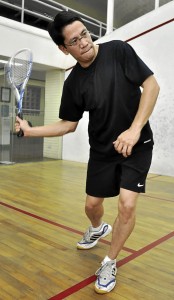
“I started with badminton. Then I saw the squash courts. I got interested in a fast yet intense sport. In badminton, I’d stay on the court for over an hour. In squash, I get a good workout in 30 to 45 minutes,” says Representative Roman Romulo, 44, who picked up the squash racket as early as 23 years ago.
“It’s instant gratification. Rain or shine you can play,” says architect Jose Pedro “Bong” Recio, 59, who also took up squash in the ‘80s.
“When I’m mad and I play squash, after an hour, I’m not mad anymore,” says Louis-Paul Heussaff, 65, chairman and CEO of Supply Oilfield Services Inc.
“(You burn) thousands of calories,” says private banker-turned-restaurateur Eduardo “Dudo” Vaca, 53, who started at 17 years old.
“These are my poster boys of squash. Even at 30, they’re fit,” Duane Santos kids about their age.
Still boyish-looking at 44, the vice president of Greenfield Development Corporation is an all-time Manila Polo Club squash champion and a former national player.
Cerebral
This indoor racket sport has been associated with private clubs and old-boy networks. The fact that not everybody plays it or can afford club membership makes it seem exclusive.
In the US, squash is considered a hot sport especially among the youth in boarding schools and Ivy League universities. The New York Times describes it as a “cerebral sport—chess in short pants.”
At Polo Club, a squash game is suffused with playful teasing.
On the squash population, Romulo explains, “There are not too many new players. Those who were playing two decades ago are the same people playing now—with few additions. The squash courts here are limited. At Polo Club there are three, compared to tennis which has more courts.”
“The gym can get boring. Here, there’s competition so you maintain excitement,” says Romulo.
Santos describes Romulo as a well-rounded sportsman. “He combines all the skills from other sports and applies them to squash. He’s so strong and fast.”
Heussaff adds, “He’s steady and has a good touch.”
Like Romulo, Recio, Vaca and Heussaff started with other racket sports. Recio was an avid pelota player. When he worked in Hong Kong, he discovered squash. A frozen shoulder forced him to shift to badminton. When it healed, he reverted to squash.
The architect looks forward to the MPC’s annual Executive Cup on October 22. “It’s a lot of fun and kantsawan.”
Says Santos of Recio, “He’s resilient and he’s so focused.”
Recio cites Vaca and Santos as the best players around. “They’re fast and responsive. They can anticipate the player’s shots and predict where the balls should go.”
Vaca, who has been playing since 1975, notes how the game has modernized. “The technology of the rackets and balls is different now. When I was 17, I could run much longer.”
Compared to tennis, he finds squash more gruelling. “You’re body is constantly moving. It gets taxing on the knee,” he says. Still, he plays aggressively even after coming from work—his new restaurant, Orchard Row at SM Megamall.
Man’s man
The buffed Heussaff seems to be the man’s man of the group.
“That’s the body I want when I’m 30!” exclaims Santos, tongue-in-cheek.
“When I grow up, I want to be like him,” Romulo rejoins.
For a man at a right age, Heussaff has a trim waistline and strong legs. He’s been working out all his life ever since he joined the French Navy at 16.
He’s been playing squash for 30 years now and was a windsurfing champion. When he started, he played two hours daily.
He kept off squash when his German partner, also a triathlete, died of ruptured aorta in the squash court. He took it up again when his son, Erwan, urged the older Heussaff to train him.
“We put so much of ourselves in one hour’s time. We burn a lot with the running. In tennis, the movement is relatively slower than squash. You are up against four walls which makes it a very fast game. In tennis, the opponent is in front of you. Here, the four walls make four opponents. You need good cardiac system. My normal heart rate is 50 bpm (beats per minute) and my blood pressure is low at 110/70. During squash my heartbeat goes up to 100 bpm.”
Heussaff reveals that his youth is not necessarily driven by sports.
“I keep young not because of these guys. It’s because my daughter brings her beautiful friends to the house,” he says. (The proud father promotes his daughter Solenn, today’s It Girl. He gives away a Solenn T-shirt and CD).
A man who loves challenges, Santos joined the national team while at Law at Ateneo. A veteran of SEA Games in the ‘90s, he recalls that the Philippines faced tough competition with Singapore and Malaysia, Commonwealth countries that have a squash tradition. He is proud that the Philippine team bagged the bronze against these world champions.
“A squash game is a war of attrition. The rallies go longer than any other sport. He who lasts longest will win,” says Santos.
To him, squash is a great stress reliever. “The workout takes your mind off everything else. When you’re there, you forget everything. You can’t think of anything else because you try to recover from every shot.”
Santos’ tactics, polished skills and grace have earned him praise from colleagues. “He knows the game, the footwork and where to place the ball,” says Romulo.
Santos attributes his fitness level to cross training—yoga, weights and running. “I work on the important S’s—speed, strength, stamina and suppleness.”
Then he breaks into a mischievous grin. “We don’t need to mention the other ‘S.’”
Is wife Mandy reading this?

